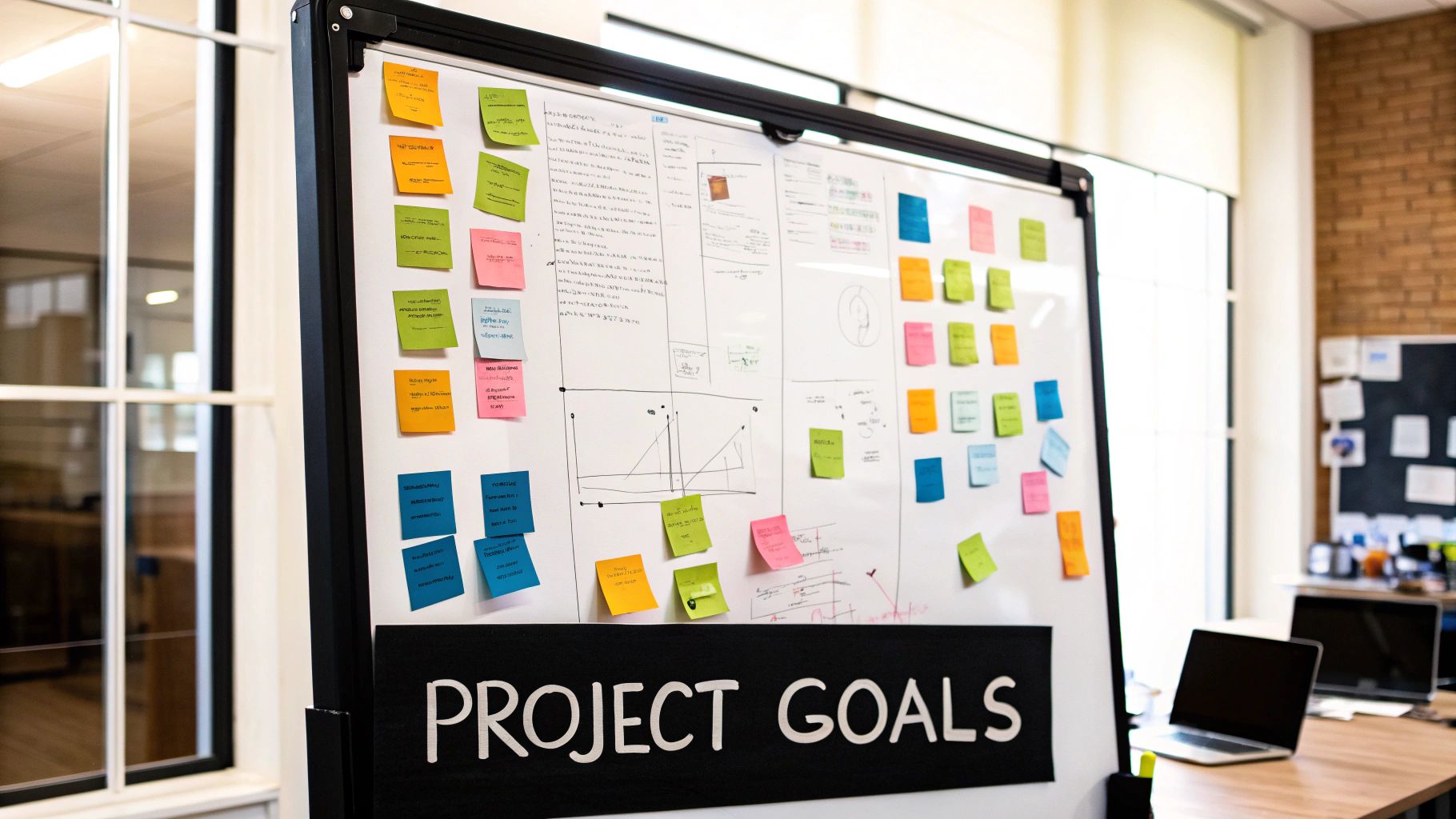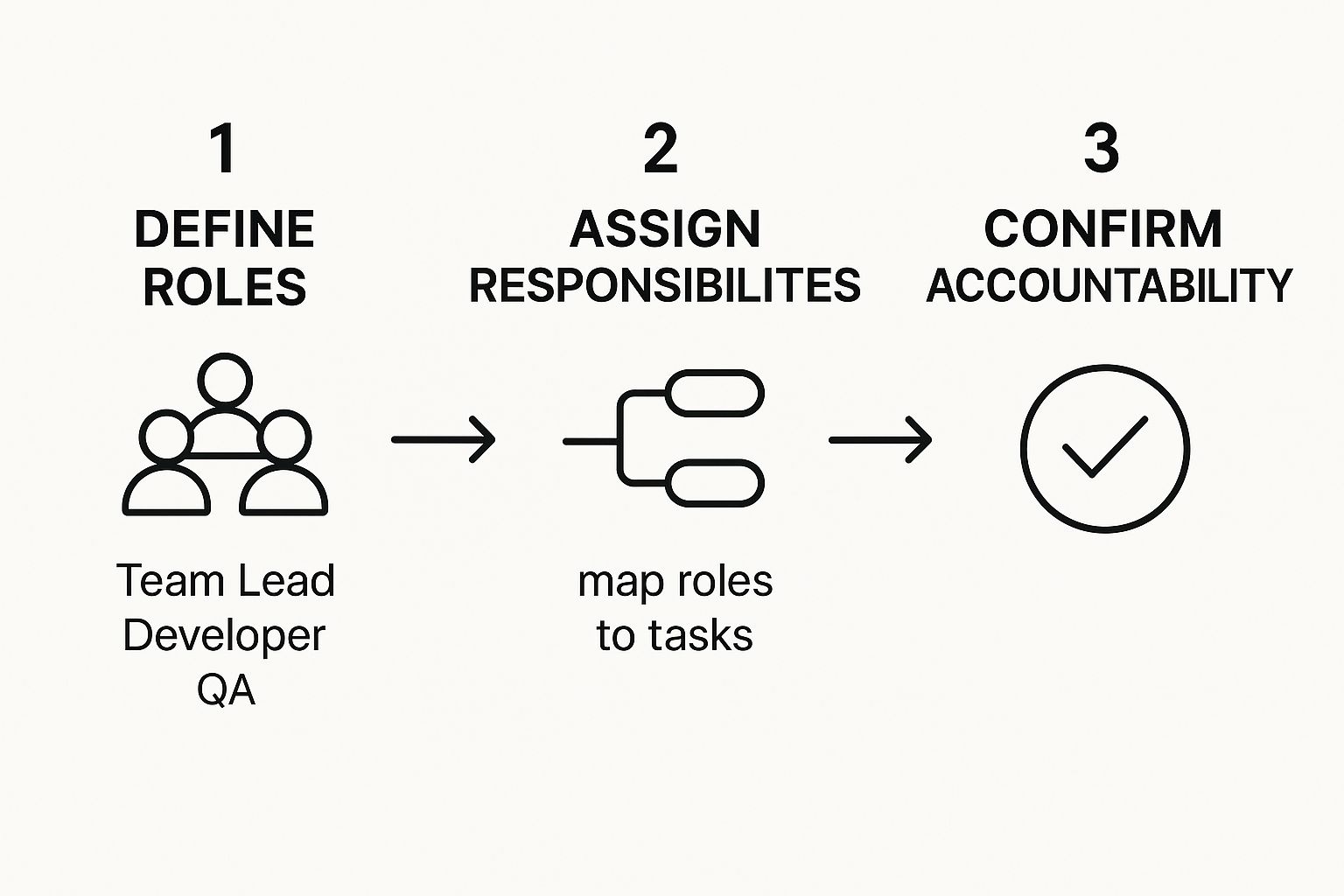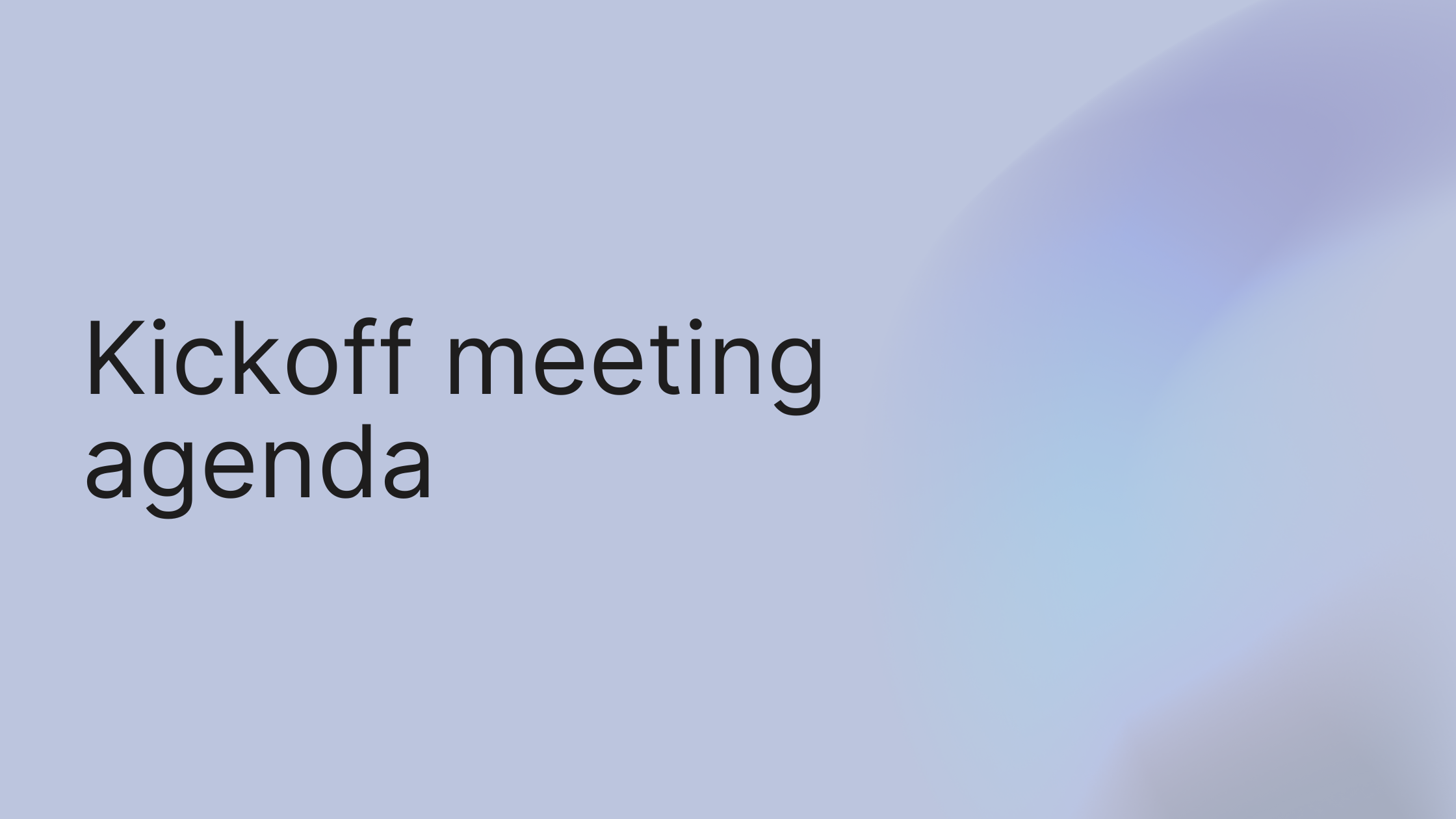Ever walked out of a project kickoff feeling more confused than when you walked in? You’re not alone. It’s the dreaded side effect of a vague, disorganized meeting that derails a project before it even starts. The quick win? A well-structured project kickoff meeting agenda. This isn't just a to-do list; it’s a strategic roadmap that aligns your entire team on goals, scope, and how you’ll win together. It's arguably the most important meeting of your project's entire lifecycle.
Why Most Project Kickoffs Fail (And How to Fix It)
Without a solid agenda, kickoff meetings quickly become aimless talk-fests that create more questions than answers. You leave with no clear next steps, fuzzy responsibilities, and a sinking feeling that you’re already behind schedule. It’s an all-too-common side effect that can derail a project before it even gets off the ground.

The fix is surprisingly simple: a well-structured project kickoff meeting agenda. This isn't just about ticking off boxes. It’s about intentionally building a foundation of shared purpose right from the start. The underlying logic is similar to any other kind of structured planning. To see how clarity prevents failure in other contexts, it's worth exploring the principles of effective outlining.
The Real-World Impact of a Poor Kickoff
I've seen this happen countless times. A marketing agency, for example, launches a website redesign for a new client. They're so eager to impress that they skip a formal agenda and jump right into showing off design mockups.
The result was a mess. The client was caught off guard by the timeline, the copywriter had no idea what the brand voice was supposed to be, and the developer was missing key functional requirements. Two weeks were completely wasted on back-and-forth emails just to get everyone aligned—a delay a single, well-planned one-hour kickoff could have easily prevented.
This initial fumble set a negative tone for the whole project. It's precisely the kind of situation that a structured kickoff, much like the first steps in the client onboarding best practices process, is designed to prevent.
The 5 Pillars of a High-Impact Kickoff Agenda
A truly effective agenda isn't just a list of topics; it's a strategic framework. I’ve found that the best ones are always built on five core pillars. Focusing on these ensures you cover all your bases and turn the meeting from a simple formality into a powerful launchpad for the project.
Here's a quick reference to keep these pillars in mind as you build your own agenda.
The 5 Pillars of a High-Impact Kickoff Agenda
Agenda Component | Primary Goal | Key Outcome |
|---|---|---|
Project Vision & Goals | Align everyone on the "why" | A shared understanding of what success looks like. |
Scope & Deliverables | Define clear boundaries | Prevents scope creep and manages expectations. |
Roles & Responsibilities | Clarify who owns what | Eliminates confusion and builds accountability. |
Timeline & Milestones | Set a realistic schedule | Everyone knows key dates and deadlines. |
Communication Plan | Establish rules of engagement | Reduces friction and ensures smooth collaboration. |
By building your agenda around these five pillars, you transform your kickoff from a procedural hoop-jump into a genuinely powerful strategic tool that gives your project the momentum it needs from day one.
Laying the Groundwork for a Successful Kickoff
Ever been tempted to fire off a last-minute meeting invite for a new project and just hope for the best? That approach is a surefire way to host a meeting that wastes everyone’s time. A truly powerful kickoff is engineered long before anyone joins the call. The secret is shifting your focus from simply hosting the meeting to strategically preparing for it.

This prep work is what turns a passive status update into an active, decision-making session where people show up ready to contribute. The growing demand for structured project management really underscores why this initial planning is so critical. With a global need for 87.7 million project management professionals projected by 2027, mastering these fundamentals isn't just a good idea—it's essential. Organizations get it, too. A solid 46% now say that detailed planning at the kickoff stage is a top priority for hitting business goals. You can explore more project management stats to see the full picture of these industry trends.
Step 1: Define Crystal-Clear Meeting Objectives
Before you even think about who to invite, define what a "win" looks like for this meeting. What absolutely must be decided by the time it ends? This isn't about the project's overall goals; these are the specific goals for the meeting itself.
For instance, instead of a vague goal like "discuss the timeline," aim for something sharp and actionable. A much better objective would be: “Finalize and agree upon the three key project milestones and their target completion dates for Q3." That focuses the conversation on a specific, measurable outcome.
A great meeting objective answers this question: "What will we have in our hands or have decided upon when this meeting is over?" If you can't answer that with confidence, you're not ready to schedule it.
Step 2: Strategically Select Your Attendees
Getting the right people in the room (or on the video call) is everything. Too many people, and you get chaos. Too few, and you risk making decisions that will just be overturned later. Your invite list should be lean, focused only on those with a direct stake in the project’s success.
Decision-Makers: This is your project sponsor or client—the person with final approval authority.
Core Team: These are the key people who will actually be doing the work, like the lead developer, lead designer, or project manager.
Key Stakeholders: Include a representative from any dependent department whose work will be directly impacted or who needs to provide critical input.
Just as important is knowing who not to invite. If someone's input is only needed for a five-minute segment, send them a detailed summary afterward instead of making them sit through the entire hour.
Step 3: Distribute Key Documents in Advance
Here’s a rule I live by: never use the kickoff meeting to introduce foundational documents for the first time. At least 48 hours before the meeting, send out a concise package of essential reading.
This packet should include:
The Project Charter or a one-page summary of it.
A draft of the Project Scope.
The meeting agenda itself, with your clearly defined objectives at the top.
This one simple step is a game-changer. It ensures attendees arrive with context, ready to ask smart questions and make informed decisions.
Pro Tip
In your prep email, link directly to a dedicated project space in growlio where all documents live. This sets an immediate precedent for centralized communication and gets the team used to your single source of truth from day one. You can pre-load your Project Charter and draft Scope right into the project files.
With this groundwork complete, you’re not just ready for a meeting; you’re ready for a productive launchpad that sets the right tone for the entire project.
Your Step-by-Step Kickoff Meeting Agenda Template
Staring at a blank document titled "Kickoff Agenda" can feel surprisingly intimidating. The secret is to stop thinking of it as a list and treat each item as a conversation starter designed to get a specific result. This actionable, step-by-step agenda ensures you're not just "discussing" topics—you're making decisions.
1. The Icebreaker (5 mins)
Skip the tired "name and title" routine. Design an icebreaker that connects to the work ahead. For a website redesign, ask everyone to share:
Their name and role.
A website they admire for its user experience, and a quick "why."
The one thing they're most excited to achieve with this new project.
This immediately gets the team thinking about the project's goals and reveals a little about each person's professional taste.
2. Project Background & Vision (10 mins)
Ground everyone in the "why." This isn't just reading the project charter aloud; it’s telling the project’s story. Frame this part of the meeting around a few key questions:
What's the real problem we're here to fix? (e.g., "Our current checkout process has a 40% cart abandonment rate.")
What's the vision for the solution? (e.g., "We're building a seamless, one-page checkout that cuts down on user frustration.")
How does this project support our bigger company goals?
Answering these questions ensures every single person understands exactly how their work plugs into the bigger picture.
3. Scope & Deliverables (15 mins)
This is the most critical part of the entire agenda. Your goal is to get explicit, verbal agreement on what is in scope and—just as crucial—what is out of scope.
Use direct, unambiguous language. Instead of a vague item like "Discuss Features," get specific: "Finalize the 'Must-Have' vs. 'Nice-to-Have' feature list for the V1 launch." This wording forces a decision-oriented conversation, not just a brainstorming session. For a deeper dive, check out our guide on creating project timelines.
4. Roles & Responsibilities (10 mins)
Nothing kills a project faster than confusion over who owns what. Use this simple flow to establish accountability and display it on screen.

Go around the room and assign a name to each key responsibility. For example: "Who is the final approver for all marketing copy?" Get a name and write it down for everyone to see.
5. Risks & Mitigation (10 mins)
Proactively address potential roadblocks. Ask the team directly: "What is the single biggest risk that could derail this project?" Brainstorm the top 2-3 risks and assign someone to own the mitigation plan for each one. This turns anxiety into action.
6. Next Steps (5 mins)
End the meeting with absolute clarity. Recap the action items, who owns them, and their due dates. Verbally confirm that everyone knows what they need to do immediately following the meeting.
With a solid agenda in hand, you’re ready to run a kickoff meeting that builds momentum, not confusion.
A Real-World Clinical Research Kickoff in Action
Ever managed a project where the stakes are so high that a single misunderstanding could cost millions or delay life-changing work? That’s the daily reality in clinical research. The secret weapon in this environment? A meticulously structured project kickoff meeting agenda that leaves absolutely no room for ambiguity.
Mini-Case Study: The Clinical Trial Launch
A project manager was tasked with kicking off a multi-year, multi-million dollar clinical trial. The team was a classic mix—senior scientists, data managers, regulatory specialists, and client sponsors—all spread across different locations. For her, failing to align this group from day one simply wasn't an option.
Her agenda included a non-negotiable section called "Protocol & Data Integrity Commitments." For this 30-minute block, she had the lead scientist and the head of data management co-present the study protocol. She visually mapped their workflow on a shared screen for everyone to see.
This wasn't just a presentation; it was a facilitated discussion. She would deliberately pause at each handoff point and ask pointed questions like, "Who is the final approver here?" and "What is the turnaround time for this data validation?" This proactive approach directly prevented a critical handoff delay that would have almost certainly occurred six months down the road. For more on this topic, discover more insights about kickoff meetings in clinical operations.
The most impactful question she asked was: "What is the single biggest risk to this handoff, and who is responsible for mitigating it?" This forced the team to proactively solve problems right there in the room, rather than just passively listening to a presentation.
Pro tip
For high-stakes projects, create a 'Decision Log' as a live document during the kickoff. Instead of just noting who is responsible for a task, document the exact decisions made during the meeting. For example: "Decision: The clinical data team will provide validated data sets to the biostatistics team within 48 hours of batch receipt. Approved by [Name]." This creates an undeniable audit trail and eliminates frustrating "I thought we decided..." conversations later on.
Seeing how a well-crafted agenda can drive success in a complex project makes the path forward clear. The next step is turning these principles into practice for your own work.
Pro Tips for Facilitating a Flawless Kickoff Meeting
You’ve put together a rock-solid agenda, but that doesn't automatically guarantee a great meeting. We’ve all seen even the best-laid plans get thrown off track by awkward silences or a discussion that completely derails. A great agenda is half the battle; the other half is how you lead.

The good news is that facilitation is a learned skill. It’s all about having a few simple techniques ready to go to keep the conversation productive and focused.
Master the Meeting Flow
Your job as the facilitator is to be a guide, not a dictator. Truly effective meeting management means you're actively navigating the human dynamics in the room.
The Dominant Voice: When one person is taking up all the oxygen, jump in gracefully. "That's a great point, Mark. To make sure we get a full picture, I'd love to hear what others are thinking. Sarah, what’s your take on this?"
The Quiet Stakeholder: Some people won't speak up unless invited. Directly pull them into the conversation. "James, your experience in data analytics is really valuable here. From your perspective, what potential roadblocks do you see?"
The Tangent: It’s bound to happen. Use the "parking lot" technique. Acknowledge the idea by saying, "That's an important topic. Let's add it to our 'parking lot' to address after this meeting. For now, let’s get back to our agenda."
Handle Virtual and Hybrid Meetings with Ease
Keeping a remote or hybrid audience engaged takes deliberate effort. You can't just let them be passive observers. Structure your agenda with built-in interaction points every 10-15 minutes.
For example, after presenting the project scope, you can launch a quick poll: "On a scale of 1-5, how confident are you that this scope is achievable for V1?" This simple action re-engages everyone and gives you a real-time pulse check. You can also use your project management tool to make things interactive.
UI Call-out: In growlio, you can create a "Key Decisions" task during the meeting and ask team members to add comments or use emojis to vote on scope items in real-time. This keeps everyone engaged and documents decisions simultaneously.
With these facilitation techniques, you can turn a good agenda into a genuinely great meeting.
Turning Your Kickoff Agenda into Action
The energy in the room is electric. Decisions have been made, and everyone is on the same page. But what happens tomorrow morning? The single biggest risk after a fantastic kickoff is letting all that powerful momentum fizzle out.
Your most critical task is to immediately bridge the gap between talk and action. That first 24-hour window is golden. It's your one shot to solidify every agreement and turn those discussion points into tangible, assigned work.
Your Post-Kickoff Action Checklist
Momentum is a fragile thing. To keep it alive, you need a disciplined follow-up process. Here’s a simple but incredibly effective checklist to run through within one business day of your kickoff.
Distribute Clear Meeting Minutes: This is not a word-for-word transcript. It's a sharp, concise summary of the key decisions, action items, and owners. Bold the most critical agreements.
Assign Action Items in Your PM Tool: Get every single task into your shared project management tool immediately, with one clear owner and a firm due date. This transparency creates instant accountability.
Share the Finalized Project Charter: Email the final, approved version of the project charter to all stakeholders. This document is now the official record, marking the project's formal start.
When you commit to turning your kickoff agenda into action, you’ll naturally improve workflow efficiency and boost your team's productivity. This post-meeting ritual is the very first step in building that efficient rhythm.
From Checklist to Continuous Action
This checklist is your launch sequence, but you need a system to keep the project in orbit. This is where a platform like growlio comes in. It helps you manage project tasks, track progress from day one, and keep every stakeholder aligned without you having to manually chase everyone down. It turns the promises made in the kickoff into a living, breathing project plan that everyone can see and contribute to.
Ready to turn that kickoff momentum into real, measurable progress? growlio provides a single workspace to manage tasks, track timelines, and keep your team perfectly aligned from day one. Start your free growlio account and make your next project a lasting success.
